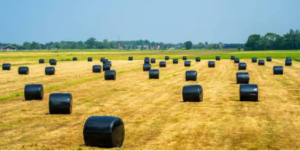In the expansive agricultural landscape of Australia, bale wrap has become an indispensable tool for farmers aiming to preserve forage quality for livestock. With the country’s diverse climate conditions, ensuring that harvested crops maintain their nutritional value throughout the year is critical. Bale wrap plays a crucial role in achieving this goal by protecting and preserving the forage, thereby supporting the productivity and health of livestock. This article delves into the significance of bale wrap in Australia, exploring its benefits, key considerations, and the emerging trends in sustainable bale wrapping solutions.
 Understanding Bale Wrap
Understanding Bale Wrap
Bale wrap is a specialised plastic film used to encase and protect bales of forage, such as hay or silage. Its primary function is to create an airtight seal around the forage, promoting anaerobic fermentation in the case of silage and preventing spoilage due to exposure to air, moisture, and pests. This preservation method ensures that the forage remains high in quality and nutrition, ready for use when fresh forage is unavailable.
The Benefits of Using Bale Wrap
- Enhanced Forage Quality
The primary advantage of using bale wrap is its ability to preserve the quality of the forage. By creating an airtight environment, bale wrap prevents the ingress of oxygen, which is essential for maintaining the anaerobic conditions required for silage fermentation. This process helps retain the nutritional content and palatability of the forage, providing livestock with high-quality feed.
- Reduction in Spoilage and Waste
In the challenging Australian climate, where conditions can vary dramatically, using bale wrap significantly reduces the risk of spoilage caused by weather, pests, and microbial activity. This reduction in spoilage translates to less waste and more efficient use of harvested crops, ultimately saving farmers time and money.
- Improved Storage Flexibility
Bale wrap allows for greater flexibility in forage storage. Wrapped bales can be stored outside without the need for additional protective structures, making it easier to manage space and reduce infrastructure costs. This flexibility is particularly beneficial for farms with limited storage facilities.
- Extended Storage Life
Properly wrapped bales have an extended storage life compared to unwrapped bales. This longevity ensures that farmers have a reliable supply of high-quality forage throughout the year, particularly during periods when fresh forage is scarce.
Key Considerations When Choosing Bale Wrap
- Material Quality
The quality of the bale wrap material is critical for ensuring effective preservation. High-quality bale wrap is typically made from multi-layered polyethylene, providing enhanced strength and durability. This construction helps the wrap withstand the physical demands of handling and storage while maintaining an airtight seal.
- UV Resistance
Given Australia’s intense sunlight, UV resistance is an essential feature for bale wrap. UV-resistant wrap prevents degradation caused by prolonged sun exposure, ensuring that the bales remain protected over extended periods.
- Stretchability and Cling
A good bale wrap should offer excellent stretchability and cling properties. It ensures that the wrap conforms tightly to the bale, maintaining an airtight seal and preventing gaps where air and moisture could enter.
- Thickness and Layers
The thickness and number of layers of the bale wrap are important factors in its effectiveness. Thicker, multi-layered wraps are more resistant to punctures and tears, providing better protection. A wrap with at least 25 microns thickness and multiple layers is generally recommended for optimal performance.
Sustainable Bale Wrap Solutions
As environmental sustainability becomes a priority in agriculture, there is growing interest in eco-friendly bale wrap options. These sustainable alternatives include biodegradable and recyclable wraps, which help reduce the environmental impact of plastic use in farming.
Recyclable Bale Wrap
Recyclable bale wrap provides another sustainable option. Farmers can recycle the used wrap instead of disposing of it in landfills. By participating in recycling programs, farmers can contribute to reducing their operations’ environmental footprint.
Conclusion
In Australia, where the agricultural sector faces diverse and often challenging conditions, bale wrap has proven to be an essential tool for forage preservation. Its ability to maintain forage quality, reduce spoilage, and offer storage flexibility makes it invaluable to farmers seeking to optimise their operations and support livestock health.
When choosing bale wrap, factors such as material quality, UV resistance, stretchability, and thickness must be considered to ensure effective preservation. Additionally, the shift towards sustainable bale wrap solutions highlights the industry’s commitment to balancing productivity with environmental responsibility.